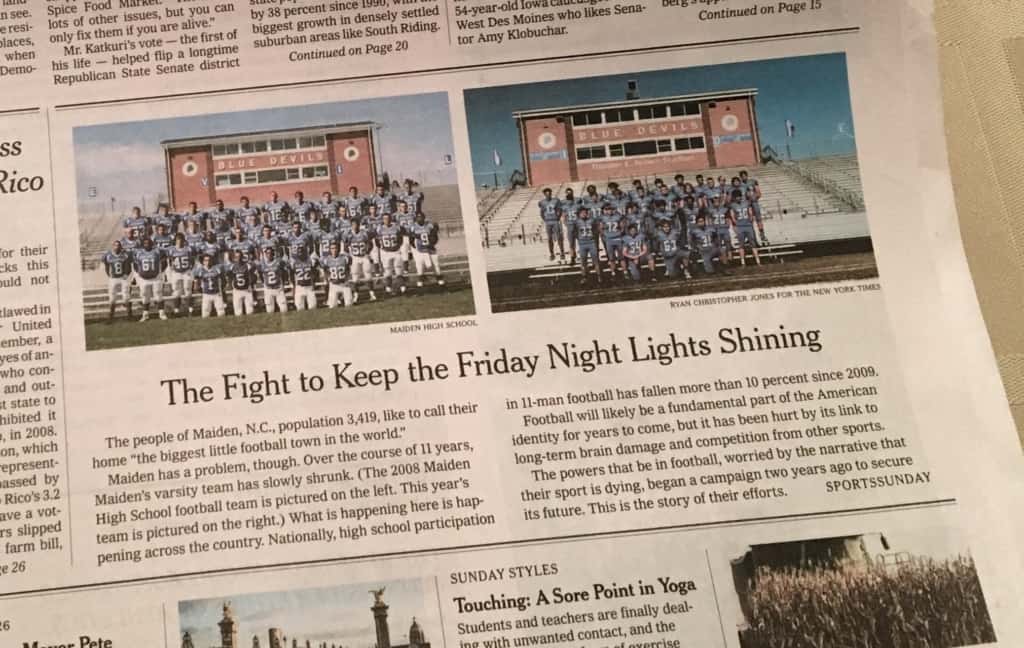

The Maiden High School football Blue Devils made a two-photo appearance Sunday on the front page of The New York Times. The color picture on the left shows 37 players in blue jerseys and white pants on the 2008 team. On the right, the 2019 team picture contains 28 players in matching blue jerseys and pants.
The teenagers of Maiden, a town of 3,419 people on highway 321 between Hickory and Gastonia, served to illustrate the notable decline in boys playing high school football across the nation and in North Carolina. The Times launched an examination of “football’s hold on America,’’ promising more stories in the coming weeks.


“Football remains far and away the country’s most popular sport,” The Times reports. “It garners huge television audiences every week, and more children play it than any other sport. But participation in youth leagues is dropping. Over the last decade, the number of high school boys playing tackle football — the heart and soul of the sport — has dropped more than 10 percent. The people who play the game are changing, too, with the number of white players diminishing as black and Hispanic players increasingly make up a larger plurality of the player pool.”
A week earlier, The News and Observer published a lengthy feature on the no-hit football practices at Apex Friendship High School in Wake County. Adam Sanders, the 33-year-old head coach, instituted the drills without hard body contact after visiting and learning from coaches at Dartmouth College.
“As research continues to link concussions to chronic traumatic encephalopathy (CTE), a disease that can cause dementia later in life, participation in high school football across North Carolina has declined 25 percent since 2010,” N&O sports writer Luke DeCock reports. “But what Sanders is doing at Apex Friendship may be the future of football and a way to save the sport for future generations.”
These newspaper reports came out just as North Carolina high school football was shifting from the regular season into playoffs, which begin tonight and stretch over the next four weeks. Stronger teams will end up playing 12, 13, 14 games.
In previous columns I’ve attempted to raise the question of whether the high school football season goes on too long — with pre-season workouts beginning in August and playoffs ending after Thanksgiving. My concern is not only with the wear-and-tear on boys’ bodies but also the time consumed that could be devoted to study and other extracurricular activities.
As someone who played football and basketball through high school — and has had season tickets for UNC Tar Heels football for decades — I’m mindful of the allure of inter-school competition, and how much football in some communities keeps teenaged boys engaged in education. And I’m also mindful of how football anchors a kind of recreational-extracurricular complex: thousands of students marching in bands and dancing as cheerleaders, thousands of parents participating in booster clubs, coaches and referees supplementing their income. Football gate receipts help finance other teams for girls and boys. The North Carolina High School Athletic Association is funded in part by dues and by a surcharge on playoff tickets.
“Significant decline in football’s prominence would represent an important cultural shift in America,” says The Times. “The sport long ago surpassed baseball as the true national pastime, both in terms of participation and fanaticism, and seeing its numbers drop represents a chance to understand in real time how quickly the ground can shift.”
North Carolina has gotten high marks for its player-safety commitment. In 2011, the General Assembly enacted and then-Gov. Bev Perdue signed a concussion awareness act, which the NCHSAA enforces. Now, several states, as The Times points out, have under consideration legislation to impose a minimum-age requirement for tackle football. No doubt, football will endure, but a moment is at hand for North Carolina to respond to the “chance to understand’’ the cultural ground of parental concern and student attitudes.
What’s the right mix of sports for boys and girls? How should schools, working with parents, discourage unhealthy athletic specialization among teenagers? Especially in large high schools, would more opportunities arise from having, say, two basketball teams or two volleyball teams? In tackle football, how many games are enough? Should no-hit practices be expanded, as they have in college and pro football?
Such questions are not only for athletic directors and coaches to resolve, but for educators and policymakers as well. As North Carolina moves to address fundamental preK-12 issues, the decline in high school football players opens an opportunity for a wider consideration of the scale, equity, and finances — and most important, the educational role — of high school athletics.


